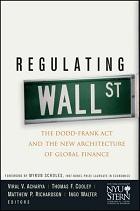As the world leaders gathered at the G20 summit to discuss how to bring the global imbalances into check, an equally important question has arisen. How to deal with the potential bubbles that might be caused by the highly accommodative monetary policies in the Western economies?
Easy money could flow from the West into "emerging" economies, potentially chasing yield there and fuelling asset price bubbles. If that happens and when those bubbles burst, we may again end up with a significant solvency shock to the financial sectors in the West. With fragile or at least stretched government balance-sheets, the best option governments and regulators have to reduce such risks may well be financial stability.
One issue the G20 must continue to address is how to reconcile the various national policies with the goal of global financial stability. As a starting point, policymakers would do well to understand the policies that have already been put in place – what works and what does not. In the US, the Dodd-Frank Act passed earlier this year represents the most sweeping set of reforms to the US financial sector since the Great Depression. Given that the global crisis began in the US (Cecchetti 2007), it is not surprising that US financial reform should be seen as essential to avoiding such crises in future (Baldwin and Eichengreen 2008, Reinhart 2008, Archarya and Richardson 2009). Yet while Dood-Frank is broadly a sensible initiative, those who look beneath the surface will find areas where the flawed design still leaves the system vulnerable and exposed.
Investigating the Dodd-Frank Act
In our recent book, Regulating Wall Street: The Dodd-Frank Act and the New Architecture of Global Finance, we provide our overall assessment of the legislation in three different ways:
- From first principles in terms of how economic theory suggests we should regulate the financial sector;
- In a comparative manner, relating the proposed reforms to those that were undertaken in the 1930s following the Great Depression;
- How the proposed reforms would have fared in preventing and dealing with the crisis of 2007 to 2009 had they been in place at the time.
This column provides a summary of some of the highlights.
The goal
The critical task for the Dodd-Frank Act is to address the increasing propensity of the financial sector to put the entire system at risk and eventually to be bailed out at taxpayer expense. Does the Dodd-Frank Act do the job? Before answering that, here are the Act’s highlights:
- Identifying and regulating systemic risk. Sets up a Systemic Risk Council that can deem non-bank financial firms as systemically important, regulate them, and, as a last resort, break them up; also establishes an office under the US Treasury to collect, analyse, and disseminate relevant information for anticipating future crises.
- Proposing an end to too-big-to-fail. Requires funeral plans and orderly liquidation procedures for unwinding of systemically important institutions, ruling out taxpayer funding of wind-downs and instead requiring that management of failing institutions be dismissed, wind-down costs be borne by shareholders and creditors, and if required, ex post levies be imposed on other (surviving) large financial firms.
- Expanding the responsibility and authority of the Federal Reserve. Grants the Fed authority over all systemic institutions and responsibility for preserving financial stability.
- Restricting discretionary regulatory interventions. Prevents or limits emergency federal assistance to individual institutions.
- Reinstating a limited form of Glass-Steagall (the Volcker Rule). Limits bank holding companies to minimal investments in proprietary trading activities, such as hedge funds and private equity, and prohibits them from bailing out these investments.
- Regulation and transparency of derivatives. Provides for central clearing of standardised derivatives, regulation of complex ones that can remain traded over the counter (that is, outside of central clearing platforms), transparency of all derivatives, and separation of non-vanilla positions into well-capitalised subsidiaries, all with exceptions for derivatives used for commercial hedging.
In addition, the Act introduces a range of reforms for mortgage lending practices, hedge fund disclosure, conflict resolution at rating agencies, requirement for securitising institutions to retain sufficient interest in underlying assets, risk controls for money market funds, and shareholder say on pay and governance. And perhaps its most popular reform, albeit secondary to the financial crisis, is:
- Creation of a Bureau of Consumer Financial Protection (BCFP). This will write rules governing consumer financial services and products offered by banks and nonbanks.
Assessing the Dodd-Frank Act
Does the Act address the key issues? Our first reaction is that it certainly has its heart in the right place. It is highly encouraging that the purpose of the new financial sector regulation is explicitly aimed at developing tools to deal with systemically important institutions. And it strives to give prudential regulators the authority and the tools to deal with this risk. Requirement of funeral plans to unwind large, complex financial institutions should help demystify their organisational structure – and the attendant resolution challenges when they experience distress or fail. If the requirement is enforced well, it could serve as a tax on complexity, which seems to be another market failure in that the private gains far exceed the social ones.
In the same vein, even though the final language in the Act is a highly diluted version of the original proposal, the Volcker Rule limiting proprietary trading investments of Large Complex Financial Institutions provides a more direct restriction on complexity and should help simplify their resolution.
The Volcker Rule also addresses the moral hazard arising from direct guarantees to commercial banks that are largely designed to safeguard payment and settlement systems and to ensure robust lending to households and corporations. Through the bank holding company structure, these guarantees effectively lower the costs for more cyclical and riskier functions such as making proprietary investments and running hedge funds or private equity funds. Yet commercial banking presence is not critical in these already thriving markets.
Equally welcome is the highly comprehensive overhaul of derivatives markets aimed at removing the veil of opacity that has led markets to seize up when a large derivatives dealer experiences problems (Bear Stearns, for example). Centralised clearing of derivatives and the push for greater transparency of prices, volumes, and exposures – to regulators and in aggregated form to the public – should enable markets to deal better with counterparty risk, in terms of pricing it into bilateral contracts, as well as understanding its likely impact. The Act also pushes for greater transparency by making systemic nonbank firms subject to tighter scrutiny by the Fed and the Securities and Exchange Commission.
Despite this, when read in its full glory, some experts have dismissed the 2,300+-page script of the Dodd-Frank Act out of hand. The Act requires over 225 new financial rules across 11 federal agencies. The attempt at regulatory consolidation has been minimal and the very regulators who dropped the ball in the current crisis have garnered more, not less, authority.
Given that the massive regulatory failure of the financial crisis needs to be fixed, however, what other options do we have? Given a choice between Congress and the admittedly imperfect regulatory bodies designing the procedures for implementing financial reform, it would not seem to be a difficult decision.
The shortcomings
That said, from the standpoint of providing a sound and robust regulatory structure, the Act falls flat on at least four important counts:
- The Act does not deal with the mispricing of pervasive government guarantees throughout the financial sector.
This will allow many financial firms to finance their activities at below-market rates and take on excessive risk.
- Systemically important firms will be made to bear their own losses but not the costs they impose on others in the system.
To this extent, the Act falters in addressing directly the primary source of market failure in the financial sector, which is systemic risk.
- In several parts, the Act regulates a financial firm by its form (bank) rather than function (banking).
This feature will prevent the Act from dealing well with the new organisational forms likely to emerge in the financial sector – to meet the changing needs of global capital markets, as well as to respond to the Act’s provisions.
- The Act makes important omissions in reforming and regulating parts of the shadow banking system that are systemically important.
It also fails to recognise that there are systemically important markets – collections of individual contracts and institutions – that also need orderly resolution when they experience freezes.
Bottom line
The net effect of these four basic faults is that implicit government guarantees to the financial sector will persist in some pockets and escalate in some others. Capital allocation may migrate in time to these pockets and newer ones that will develop in the future in the shadow banking world and, potentially, sow seeds of the next significant crisis. Implementation of the Act and future regulation should guard against this danger.
In the end, we applaud the Dodd-Frank Act’s ambition and its attempt to rewrite financial sector regulation. The Act does represent the culmination of several months of sincere effort on the part of the legislators, their staffers, the prudential regulators, academics, policy think tanks, and, of course, the financial industry (and the lobbyists).
But it is equally important to recognise that the most ambitious overhaul of the financial sector regulation in our times does not fully address private incentives of individual institutions to put the system at risk, it leaves a great deal of uncertainty as to how we will resolve future crises, and it is likely to be anachronistic, in parts, right from the day of its legislation. Not all is lost, though, and these limitations can be fixed in due course. To understand how, read our book.
This article is based on the Prologue from our book “Regulating Wall Street: The Dodd-Frank Act and the New Architecture of Global Finance”, NYU-Stern and John Wiley & Sons. Listen to Viral Acharya discussing the book in a recent Vox Talks interview here.
References
Acharya, Viral and Matthew Richardson (2009), “Repairing a failed system”, VoxEU.org, 7 February.
Baldwin, Richard and Barry Eichengreen (2008), “Rescuing our jobs and savings: What G7/8 leaders can do to solve the global credit crisis”, VoxEU.org, 9 October.
Cecchetti, Stephen (2007), “Federal Reserve policy actions in August 2007: Frequently asked questions (updated)”, VoxEU.org, 15 August.
Reinhart, Carmen M (2008), “Reflections on the International Dimensions and Policy Lessons of the US Subprime Crisis”, VoxEU.org, 15 March.







